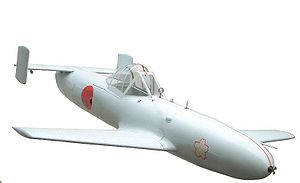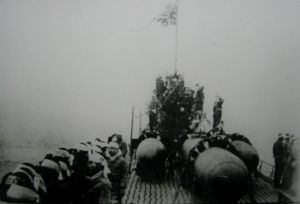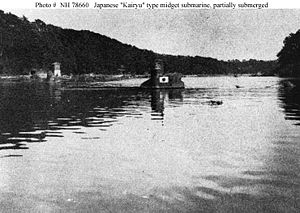
Japanese Special Attack Units
Encyclopedia
During World War II
, Japanese Special Attack Units (特別攻撃隊 tokubetsu kōgeki tai?, often abbreviated to 特攻隊 tokkōtai), also called shimbu-tai, were specialized units of the Imperial Japanese Navy
and Imperial Japanese Army
normally used for suicide missions. They included kamikaze
bombers, Fukuryu
("Crouching Dragon", suicide scuba divers), and several types of suicide ships and submarines.
 The Yokosuka
The Yokosuka
MXY-7 Ohka
(桜花 "cherry blossom") was a purpose-built kamikaze aircraft employed by the Imperial Japanese Navy Air Service
towards the end of World War II. The US
gave the aircraft the Japanese
name Baka
("idiot").
It was a small flying bomb
that was carried underneath a Mitsubishi G4M
"Betty", Yokosuka P1Y
Ginga "Frances" (guided Type 22) or planned Heavy Nakajima G8N
Renzan "Rita" (transport type 43A/B) bomber
to within range of its target; on release, the pilot would first glide towards the target and when close enough he would fire the Ohkas engine(s) and dive against the ship to destroy. That final approach was almost unstoppable (especially for Type 11) because the aircraft gained tremendous speed. Later versions were designed to be launched from coastal air bases and caves, and even from submarine
s equipped with aircraft catapult
s, although none were actually used this way.
(神龍 - "Divine Dragon") was a proposed rocket-powered kamikaze aircraft designed for the Imperial Japanese Navy
towards the end of World War II. It never reached production.
Tsurugi (剣 "Sword") was a one-man kamikaze aircraft developed by the Imperial Japanese Army Air Force in the closing stages of World War II in late 1945
.
(梅花 - "Ume
Blossom") was a pulsejet-powered kamikaze aircraft under development for the Imperial Japanese Navy
towards the end of World War II. The war ended before any were built. The design was greatly inspired by the manned version of the German V1 flying bomb, the Fieseler Fi 103R "Reichenberg".
 The Shinyo (震洋 "Sea Quake") were Japanese suicide boats developed during World War II. They were part of the wider Special Attack Units program. These fast motorboats were driven by one man, to speeds of around 30 kn (58.8 km/h; 36.5 mph). They were typically equipped with two depth charges as explosives.
The Shinyo (震洋 "Sea Quake") were Japanese suicide boats developed during World War II. They were part of the wider Special Attack Units program. These fast motorboats were driven by one man, to speeds of around 30 kn (58.8 km/h; 36.5 mph). They were typically equipped with two depth charges as explosives.
Around 6,200 Shinyo were produced for the Imperial Japanese Navy
and 3,000 Maru-Ni for the Imperial Japanese Army
. Around 400 were affected to Okinawa and Formosa
, and the rest were stored on the coast of Japan for the ultimate defense against the invasion of the Home islands.
 The Kaiten
The Kaiten
( "Change the World") was a torpedo
modified as a suicide weapon, and used by the Imperial Japanese Navy
in the final stages of World War II. Kaiten means returning to the heavens.
Early designs allowed for the pilot to escape after the final acceleration towards the target, although whether this could have been done successfully is doubtful. There is no record of any pilot attempting to escape or intending to do so, and this provision was dropped from later production kaitens. The inventor of the Kaiten, Lt. Kurokee was lost during one of the first training missions. When the sub was raised a note was found with a note written during his final minutes before death, sending his respects to his family and detailing the cause of the accident and how to repair the defect.
 The Kairyu
The Kairyu
(海龍 "Sea Dragon") was a class of kamikaze midget submarine
s of the Imperial Japanese Navy
, designed in 1943-1944, and produced from the beginning of 1945. These submarines were meant to meet the invading American Naval forces upon their anticipated approach of Tokyo.
These submarines had a two-man crew and were fitted with an internal warhead for suicide missions. Over 760 of these submarines were planned, and by August 1945, 200 had been manufactured, most of them at the Yokosuka shipyard.
"Crouching dragons") were a part of the Special Attack Units prepared to resist the invasion of the Home islands by Allied forces. They were armed with a mine
containing 15 kg (33.1 lb) of explosive, fitted to a 5 m (16.4 ft) bamboo pole. They would dive and stick the pole into the hull of an enemy ship, destroying themselves in the process. They were equipped with a diving jacket and trousers, diving shoes, and a diving helmet fixed by four bolts.
They were typically weighed down with 9 kg (19.8 lb) of lead, and had two bottles of compressed air at 150 bars. They were expected to be able to walk at a depth of 5 to 7 m (16.4 to 23 ft), for about six hours.
This new weapon is only known to have been used a few times operationally:
Several deaths occurred during training due to malfunctions.
World War II
World War II, or the Second World War , was a global conflict lasting from 1939 to 1945, involving most of the world's nations—including all of the great powers—eventually forming two opposing military alliances: the Allies and the Axis...
, Japanese Special Attack Units (特別攻撃隊 tokubetsu kōgeki tai?, often abbreviated to 特攻隊 tokkōtai), also called shimbu-tai, were specialized units of the Imperial Japanese Navy
Imperial Japanese Navy
The Imperial Japanese Navy was the navy of the Empire of Japan from 1869 until 1947, when it was dissolved following Japan's constitutional renunciation of the use of force as a means of settling international disputes...
and Imperial Japanese Army
Imperial Japanese Army
-Foundation:During the Meiji Restoration, the military forces loyal to the Emperor were samurai drawn primarily from the loyalist feudal domains of Satsuma and Chōshū...
normally used for suicide missions. They included kamikaze
Kamikaze
The were suicide attacks by military aviators from the Empire of Japan against Allied naval vessels in the closing stages of the Pacific campaign of World War II, designed to destroy as many warships as possible....
bombers, Fukuryu
Fukuryu
Suicide divers were a part of the Japanese Special Attack Units prepared to resist the invasion of the Home islands by Allied forces. They were armed with a mine containing of explosive, fitted to a bamboo pole. They would dive and stick the pole into the hull of an enemy ship, destroying...
("Crouching Dragon", suicide scuba divers), and several types of suicide ships and submarines.
Rocket plane Ohka

Yokosuka Naval Air Technical Arsenal
had many names, each depending on the period of its existence, and the circumstances at that time. Many of the names were acronyms that were derived from its military name or designation, which changed from time to time. The arsenal was sometimes known as "Kūgi-shō"...
MXY-7 Ohka
Ohka
The Yokosuka MXY-7 Ohka was a purpose-built, rocket powered human-guided anti-shipping kamikaze attack plane employed by Japan towards the end of World War II...
(桜花 "cherry blossom") was a purpose-built kamikaze aircraft employed by the Imperial Japanese Navy Air Service
Imperial Japanese Navy Air Service
The Imperial Japanese Navy Air Service was the air arm of the Imperial Japanese Navy during World War II, the organization was responsible for the operation of naval aircraft and the conduct of aerial warfare in the Pacific War.It was controlled by the Navy Staff of the Imperial Japanese Navy and...
towards the end of World War II. The US
United States
The United States of America is a federal constitutional republic comprising fifty states and a federal district...
gave the aircraft the Japanese
Japanese language
is a language spoken by over 130 million people in Japan and in Japanese emigrant communities. It is a member of the Japonic language family, which has a number of proposed relationships with other languages, none of which has gained wide acceptance among historical linguists .Japanese is an...
name Baka
Baka (fool)
Baka is a frequently used Japanese word meaning "fool; idiot; jerk; dolt; imbecile; foolish; stupid; worthless; absurd; ridiculous; idiotic".-Word:...
("idiot").
It was a small flying bomb
Flying bomb
A flying bomb is a manned or unmanned aerial vehicle or aircraft carrying a large explosive warhead, a precursor to contemporary cruise missiles...
that was carried underneath a Mitsubishi G4M
Mitsubishi G4M
The Mitsubishi G4M 一式陸上攻撃機, 一式陸攻 Isshiki rikujō kōgeki ki, Isshikirikkō was the main twin-engine, land-based bomber used by the Imperial Japanese Navy Air Service in World War II. The Allies gave the G4M the reporting name Betty...
"Betty", Yokosuka P1Y
Yokosuka P1Y
|-See also:-References:NotesBibliography* Francillon, Ph.D., René J. Japanese Aircraft of the Pacific War. London: Putnam 7 Company Ltd., 1970. ISBN 0-370-00033-1 ....
Ginga "Frances" (guided Type 22) or planned Heavy Nakajima G8N
Nakajima G8N
|-See also:-References:NotesBibliography* Collier, Basil. Japanese Aircraft of World War II. New York: Mayflower Books, 1979. ISBN 0-8317-5137-1....
Renzan "Rita" (transport type 43A/B) bomber
Bomber
A bomber is a military aircraft designed to attack ground and sea targets, by dropping bombs on them, or – in recent years – by launching cruise missiles at them.-Classifications of bombers:...
to within range of its target; on release, the pilot would first glide towards the target and when close enough he would fire the Ohkas engine(s) and dive against the ship to destroy. That final approach was almost unstoppable (especially for Type 11) because the aircraft gained tremendous speed. Later versions were designed to be launched from coastal air bases and caves, and even from submarine
Submarine
A submarine is a watercraft capable of independent operation below the surface of the water. It differs from a submersible, which has more limited underwater capability...
s equipped with aircraft catapult
Aircraft catapult
An aircraft catapult is a device used to launch aircraft from ships—in particular aircraft carriers—as a form of assisted take off. It consists of a track built into the flight deck, below which is a large piston or shuttle that is attached through the track to the nose gear of the aircraft, or in...
s, although none were actually used this way.
Shinryu
The Mizuno ShinryuMizuno Shinryu
The Mizuno Shinryu was a late-World War II Japanese rocket-powered suicide interceptor concept. The project never proceeded beyond the initial phase of development.-Configuration:...
(神龍 - "Divine Dragon") was a proposed rocket-powered kamikaze aircraft designed for the Imperial Japanese Navy
Imperial Japanese Navy
The Imperial Japanese Navy was the navy of the Empire of Japan from 1869 until 1947, when it was dissolved following Japan's constitutional renunciation of the use of force as a means of settling international disputes...
towards the end of World War II. It never reached production.
Tsurugi
The Nakajima Ki-115Nakajima Ki-115
|-See also:-References:NotesBibliography* Francillon, Ph.D., René J. Japanese Aircraft of the Pacific War. London: Putnam & Company Ltd., 1979. ISBN 0-370-30251-6....
Tsurugi (剣 "Sword") was a one-man kamikaze aircraft developed by the Imperial Japanese Army Air Force in the closing stages of World War II in late 1945
1945 in aviation
This is a list of aviation-related events from 1945:- Events :* The probe-and-drogue aerial refueling system, in which the tanker aircraft trails a hose with a stabilizing conical drogue at its end which mates to a fixed probe mounted on the receiving aircraft, is perfected...
.
Baika
The Kawanishi BaikaKawanishi Baika
The Kawanishi Baika was a pulsejet-powered kamikaze aircraft under development for the Imperial Japanese Navy towards the end of World War II. The war ended before any were built.-History:...
(梅花 - "Ume
Ume
Prunus mume, with the common names including Chinese plum and Japanese apricot, is an Asian tree species classified in the Armeniaca section of the genus Prunus. The flower, long a beloved subject in the traditional painting of East Asia, is usually translated as plum blossom. This distinct tree...
Blossom") was a pulsejet-powered kamikaze aircraft under development for the Imperial Japanese Navy
Imperial Japanese Navy
The Imperial Japanese Navy was the navy of the Empire of Japan from 1869 until 1947, when it was dissolved following Japan's constitutional renunciation of the use of force as a means of settling international disputes...
towards the end of World War II. The war ended before any were built. The design was greatly inspired by the manned version of the German V1 flying bomb, the Fieseler Fi 103R "Reichenberg".
Boats

Around 6,200 Shinyo were produced for the Imperial Japanese Navy
Imperial Japanese Navy
The Imperial Japanese Navy was the navy of the Empire of Japan from 1869 until 1947, when it was dissolved following Japan's constitutional renunciation of the use of force as a means of settling international disputes...
and 3,000 Maru-Ni for the Imperial Japanese Army
Imperial Japanese Army
-Foundation:During the Meiji Restoration, the military forces loyal to the Emperor were samurai drawn primarily from the loyalist feudal domains of Satsuma and Chōshū...
. Around 400 were affected to Okinawa and Formosa
Taiwan
Taiwan , also known, especially in the past, as Formosa , is the largest island of the same-named island group of East Asia in the western Pacific Ocean and located off the southeastern coast of mainland China. The island forms over 99% of the current territory of the Republic of China following...
, and the rest were stored on the coast of Japan for the ultimate defense against the invasion of the Home islands.
Kaiten

Kaiten
The Kaiten were manned torpedos and suicide craft, they were used by the Imperial Japanese Navy in the final stages of World War II.-History:...
( "Change the World") was a torpedo
Torpedo
The modern torpedo is a self-propelled missile weapon with an explosive warhead, launched above or below the water surface, propelled underwater towards a target, and designed to detonate either on contact with it or in proximity to it.The term torpedo was originally employed for...
modified as a suicide weapon, and used by the Imperial Japanese Navy
Imperial Japanese Navy
The Imperial Japanese Navy was the navy of the Empire of Japan from 1869 until 1947, when it was dissolved following Japan's constitutional renunciation of the use of force as a means of settling international disputes...
in the final stages of World War II. Kaiten means returning to the heavens.
Early designs allowed for the pilot to escape after the final acceleration towards the target, although whether this could have been done successfully is doubtful. There is no record of any pilot attempting to escape or intending to do so, and this provision was dropped from later production kaitens. The inventor of the Kaiten, Lt. Kurokee was lost during one of the first training missions. When the sub was raised a note was found with a note written during his final minutes before death, sending his respects to his family and detailing the cause of the accident and how to repair the defect.
Kairyu

Kairyu class submarine
The was a class of midget submarines of the Imperial Japanese Navy, designed in 1943–1944, and produced from the beginning of 1945. These submarines were meant to meet the invading American naval forces upon their anticipated approach of Tokyo.-History:...
(海龍 "Sea Dragon") was a class of kamikaze midget submarine
Midget submarine
A midget submarine is any submarine under 150 tons, typically operated by a crew of one or two but sometimes up to 6 or 8, with little or no on-board living accommodation...
s of the Imperial Japanese Navy
Imperial Japanese Navy
The Imperial Japanese Navy was the navy of the Empire of Japan from 1869 until 1947, when it was dissolved following Japan's constitutional renunciation of the use of force as a means of settling international disputes...
, designed in 1943-1944, and produced from the beginning of 1945. These submarines were meant to meet the invading American Naval forces upon their anticipated approach of Tokyo.
These submarines had a two-man crew and were fitted with an internal warhead for suicide missions. Over 760 of these submarines were planned, and by August 1945, 200 had been manufactured, most of them at the Yokosuka shipyard.
Divers
Suicide divers ' onMouseout='HidePop("26633")' href="/topics/Fukuryu">FukuryuFukuryu
Suicide divers were a part of the Japanese Special Attack Units prepared to resist the invasion of the Home islands by Allied forces. They were armed with a mine containing of explosive, fitted to a bamboo pole. They would dive and stick the pole into the hull of an enemy ship, destroying...
"Crouching dragons") were a part of the Special Attack Units prepared to resist the invasion of the Home islands by Allied forces. They were armed with a mine
Naval mine
A naval mine is a self-contained explosive device placed in water to destroy surface ships or submarines. Unlike depth charges, mines are deposited and left to wait until they are triggered by the approach of, or contact with, an enemy vessel...
containing 15 kg (33.1 lb) of explosive, fitted to a 5 m (16.4 ft) bamboo pole. They would dive and stick the pole into the hull of an enemy ship, destroying themselves in the process. They were equipped with a diving jacket and trousers, diving shoes, and a diving helmet fixed by four bolts.
They were typically weighed down with 9 kg (19.8 lb) of lead, and had two bottles of compressed air at 150 bars. They were expected to be able to walk at a depth of 5 to 7 m (16.4 to 23 ft), for about six hours.
This new weapon is only known to have been used a few times operationally:
- January 8, 1945: Damage by suicide divers to Infantry landing craft (gunboat) LCI(G)-404 in Yoo Passage, Palaus.
- February 10, 1945: Attempted attack by suicide divers on surveying ship Hydrographer (AGS-2) in Schonian Harbor, Palaus.
Several deaths occurred during training due to malfunctions.
External links
- Japanese suicide weapons
- O'Neill, Suicide Squads - book that describes Japan's various types of special attack units
- Kamikaze Images - web site that covers all types of Japan's special attack forces

